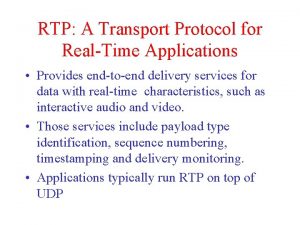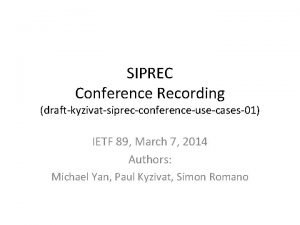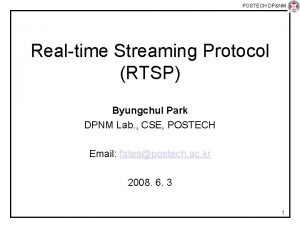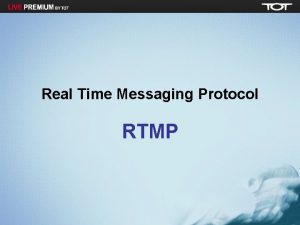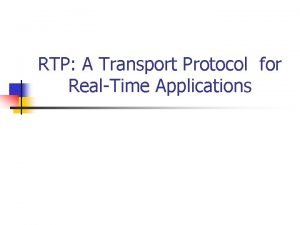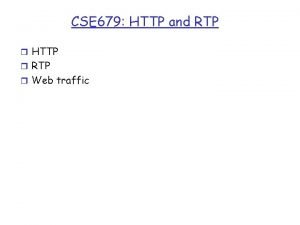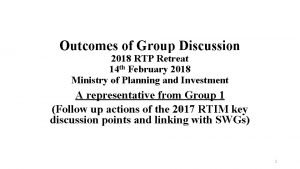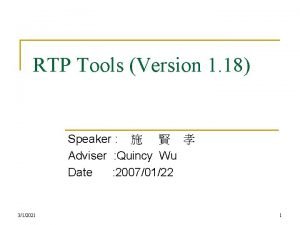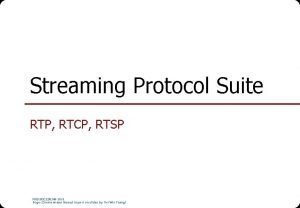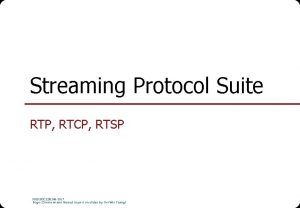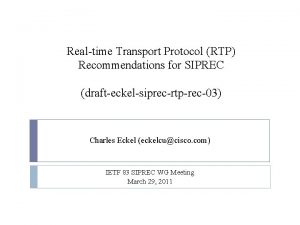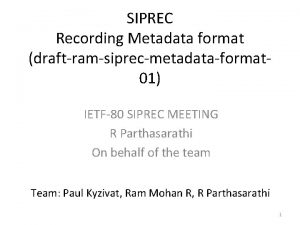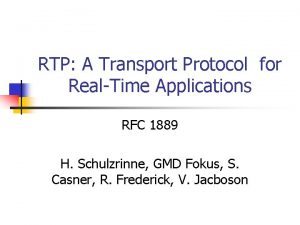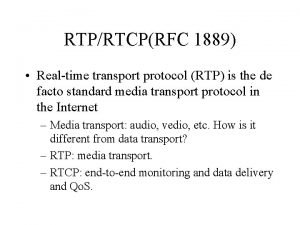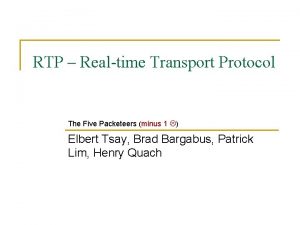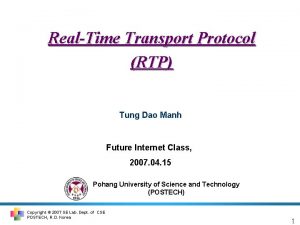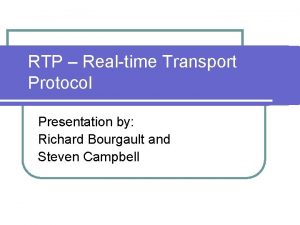Realtime Transport Protocol RTP Recommendations for SIPREC drafteckelsiprecrtprec01












- Slides: 12

Real-time Transport Protocol (RTP) Recommendations for SIPREC (draft-eckel-siprec-rtp-rec-01) Charles Eckel (eckelcu@cisco. com) IETF-81, Quebec City, July 25 -29, 2011

Purpose Provides recommendations and guidelines for RTP and RTCP in the context of SIPREC. In order to communicate most effectively, the Session Recording Client (SRC) and the Session Recording (SRS) SHOULD utilize the mechanisms provided by RTP in a well defined and predicable manner. It is the goal of this document to make the reader aware of these mechanisms and provide recommendations and guidelines. Exists as a standalone document to facilitate discussion of the recommendations Anticipated that portions of this document will be incorporated into draft-portman-siprec-protocol

Contents Roles - SRC acting as an RTP Translator/Mixer/Endpoint RTCP - feedback and Identification RTP Profile – AVP/AVFP, SAVP/SAVPF SSRC, CSRC SDES and CNAME Keepalive – for inactive and recvonly/sendonly streams RTCP Feedback Messages – FIR, PLI, TMMBR Symmetric RTP/RTCP

Issue 1: RFC 2119 Language Draft current states: This document is completely informational. It includes no requirements and no normative language. Within the protocol draft, we state requirements Proposed solution: Update entire draft to use RFC 2119 language as deemed appropriate for inclusion within the protocol draft

Issue 2: SRC Positioning UA <-- CS --> SRC <-- RS --> SRS Figure 1: UA as SRC Figure was subject to multiple comments/clarifications. Propose adding: SRS ^ | RS | v UA <-- CS 1 --> SRC <-- CS 2 --> UA 2 Figure 2: B 2 BUA as SRC May reuse artwork from draft-ietf-siprec-architecture 02

Issue 3: Roles – Translator/Mixer/Endpoint Many comments/questions on this section Not just one two of translator Translator/Mixer start to blur Many options for handling of RTCP Options: 1. remove entirely and provide general RTP/RTCP handling requirements and recommendations 2. subdivide translator into two (forwarder and translator) 3. recommend a particular model and describe that only

Issue 4: Single vs. Multiple SDES Packets The Source Description (SDES), as defined in [RFC 3550], contains an SSRC/CSRC identifier followed by a list of zero or more items, which carry information about the SSRC/CSRC. End systems send one SDES packet containing their own source identifier (the same as the SSRC in the fixed RTP header). A mixer sends one SDES packet containing a chunk for each contributing source from which it is receiving SDES information, or multiple complete SDES packets. Proposed Solution: Add -. . . if there are more than 31 such sources.

Issue 5: FIR vs. PLI FIR: Full Intra Request PLI: Picture Loss Indication Requires the media sender sends a Decoder Refresh Point at the earliest opportunity Informs the encoder of the loss of an undefined amount of coded video data belonging to one or more pictures MAY transmit an intra-picture to achieve resynchronization Currently draft states: Using the FIR command to recover from errors is explicitly disallowed, and instead the PLI message defined in AVPF [RFC 4585] should be used. The PLI message reports lost pictures and has been included in AVPF for precisely that purpose.

Issue 5: FIR vs. PLI (cont) RFC 5104 states: FIR SHALL NOT be sent as a reaction to picture losses -- it is RECOMMENDED to use PLI instead. FIR SHOULD be used only in situations where not sending a decoder refresh point would render the video unusable for the users. Example where sending FIR is appropriate: multipoint conference, a new user joins the session and no regular decoder refresh point interval is established video switching MCU that changes streams Proposed Solution: Add this clarification to draft

Issue 6: Symmetric RTP/RTCP Proposed solution: Reword as follows: Within an SDP offer/answer exchange, RTP entities choose the RTP and RTCP transport addresses (i. e. , IP addresses and port numbers) on which to receive packets. When sending packets, the RTP entities may use the same source port or a different source port as those signaled for receiving packets. When the transport address used to send and receive RTP is the same, it is termed "symmetric RTP" [RFC 4961]. Likewise, when the transport address used to send and receive RTCP is the same, it is termed

Issue 6: Symmetric RTP/RTCP (cont) Proposed solution: (cont) When sending RTP, it is REQUIRED to use symmetric RTP. When sending RTCP, it is REQUIRED to use symmetric RTCP. Although an SRS will not normally send RTP to an SRC, it will send RTCP as well as receive RTP and RTCP. Likewise, although an SRC will not normally receive RTP from an SRS, it will receive RTCP as well as send RTP and RTCP. Note: Symmetric RTP and symmetric RTCP are different from RTP/RTCP multiplexing [RFC 5761]. .

Thank You Charles Eckel (eckelcu@cisco. com) IETF-81, Quebec City, July 25 -29, 2011
